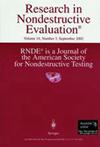基于嵌入式压电传感器的混凝土缺陷非线性超声二次谐波检测
IF 1
4区 材料科学
Q3 MATERIALS SCIENCE, CHARACTERIZATION & TESTING
引用次数: 8
摘要
摘要:本文研究了基于嵌入式压电传感器的二次谐波产生(SHG)技术,用于混凝土样品的缺陷评估。对混凝土养护过程中的内部毛细空洞、受压开裂损伤和弯曲荷载三种不同的缺陷形式进行了研究和分析。对时域信号进行傅里叶变换,得到清晰的二次谐波,基频信号振幅的平方与二次谐波幅值呈理论预期的线性关系。非线性参数对三种情况下不同状态下的样本有很好的区分,表明基于嵌入式传感器的SHG技术是完全可行的。此外,非线性参数与混凝土内部毛细空隙和裂缝的变化具有良好的相关性。通过将非线性参数与瑞利波相速度和振动共振频率这两个传统的线性参数进行比较,进一步验证了所开发的SHG技术的高灵敏度。本研究的实验结果表明,嵌入式传感器在混凝土结构的非线性超声无损评价中具有广阔的应用前景,特别是作为一种低成本的商用超声换能器的替代品。本文章由计算机程序翻译,如有差异,请以英文原文为准。
Nonlinear Ultrasonic Second Harmonic Assessment of Concrete Defects Based on Embedded Piezoelectric Sensors
ABSTRACT In this work, the second harmonic generation (SHG) technique based on embedded piezoelectric (PZT) sensors is developed for the defect assessment of concrete samples. Three different imperfection forms of concrete including internal capillary void during the curing process, cracking damage due to compression, and bending loads are examined and analyzed. Clear second harmonics are observed by Fourier transform of time domain signal, and the square of fundamental signal amplitude shows a linear relation with the second harmonic amplitude as theoretically expected. The nonlinear parameter presents a good distinction for samples in different states of three cases, indicating the well-round feasibility of SHG technique based on embedded sensors. In addition, the nonlinear parameter presents an excellent correlation with the variation of internal capillary void and cracks in concrete. The high sensitivity of the developed SHG technique is further validated through a comparison between the nonlinear parameter and two traditional linear parameters, namely the phase velocity of Rayleigh wave and the resonance frequency of vibrations. Experimental results in this study demonstrate that the embedded sensors are promising for the nonlinear ultrasonic nondestructive evaluation of concrete structures, particularly as a low-cost alternative of commercial ultrasonic transducers.
求助全文
通过发布文献求助,成功后即可免费获取论文全文。
去求助
来源期刊

Research in Nondestructive Evaluation
工程技术-材料科学:表征与测试
CiteScore
2.30
自引率
0.00%
发文量
14
审稿时长
>12 weeks
期刊介绍:
Research in Nondestructive Evaluation® is the archival research journal of the American Society for Nondestructive Testing, Inc. RNDE® contains the results of original research in all areas of nondestructive evaluation (NDE). The journal covers experimental and theoretical investigations dealing with the scientific and engineering bases of NDE, its measurement and methodology, and a wide range of applications to materials and structures that relate to the entire life cycle, from manufacture to use and retirement.
Illustrative topics include advances in the underlying science of acoustic, thermal, electrical, magnetic, optical and ionizing radiation techniques and their applications to NDE problems. These problems include the nondestructive characterization of a wide variety of material properties and their degradation in service, nonintrusive sensors for monitoring manufacturing and materials processes, new techniques and combinations of techniques for detecting and characterizing hidden discontinuities and distributed damage in materials, standardization concepts and quantitative approaches for advanced NDE techniques, and long-term continuous monitoring of structures and assemblies. Of particular interest is research which elucidates how to evaluate the effects of imperfect material condition, as quantified by nondestructive measurement, on the functional performance.
 求助内容:
求助内容: 应助结果提醒方式:
应助结果提醒方式:


